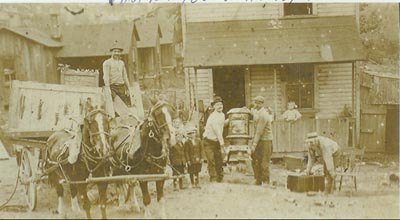Sign up for the Family Tree Newsletter Plus, you’ll receive our 10 Essential Genealogy Research Forms PDF as a special thank you!
Get Your Free Genealogy Forms
"*" indicates required fields

Emery Veres, born in 1882, smiled at the camera from the back of a wagon for this undated photo. His great-granddaughter, Cindy Nichols would like some help figuring out where this photo was taken.
She has two pieces of information—her ancestor’s name and his birth date—that could help her fill in the missing pieces of his life, such as where he lived and when. A quick search of Ancestry.com’s US Census subscription databases turns up one hit: The 1920 census lists an Emery Veres in Ohio. After double-checking with Nichols, I discovered this wasn’t the right man. In 1920, her relative lived in Pennsylvania, where he worked in coal mines. Another search for all the Vereses in Pennsylvania finds him listed as Ed, with a wife, Mary, and several children. This Veres emigrated from Hungary in 1902. It’s important not to jump to conclusions even when researching an unusual name—look for all individuals with the surname before deciding whether you have the correct person.
The next step is to try to date the picture based on clothing. Establishing a date for men’s work clothes is a challenge: Laborers didn’t always wear the current fashion. The caps on the man holding the stove and the two little boys weren’t unique to any one era. They stayed in vogue for decades. Likewise, wide-brimmed straw hats like the one on the man with the chair date from the late 1880s through the mid-20th century. The man to one side of the stove wears a pullover sweater, which came into style in the late 19th century.
Veres’ hat, with its close-fitting crown and wide brim in front, is probably a regional or work fashion, not a current style. The little girl on the porch wears a full-sleeved dress with a bow in her hair. Girls have worn bows in many cultures, but they became fashionable in the United States in the early 20th century. Her dress sleeves date from around 1910.
Was this picture taken in Pennsylvania or in Veres’ homeland, Hungary? The unusual architecture in the background is worker housing; the more traditional dwelling in the center of the image could be for the site supervisor.
It’s definitely moving day for someone in this picture. The men in the center carry a wood stove to Veres for loading onto the wagon; the man on the right is preparing to pick up a suitcase and chair. All the kids are fascinated by the photographer. The only unusual feature is the markings on the front of the wagon, which could be Hungarian or a logo of the mine.
The final date for this photo relies on the children. In 1920 Veres listed a large family: three daughters (born 1906, 1913 and 1915) and five sons (born 1908, 1909, 1916, 1918 and 1920). Some of the children here could be his, specifically, the two boys near the horses. They’re probably ages 5 and 6, and they wear similar outfits. If they’re Veres’ sons, this picture dates about 1914 and was taken in Pennsylvania. To confirm this identification, Nichols will need to compare this photo to pictures of Veres’ children. <!–
Watch for props. –><!–
2000–>
ADVERTISEMENT

